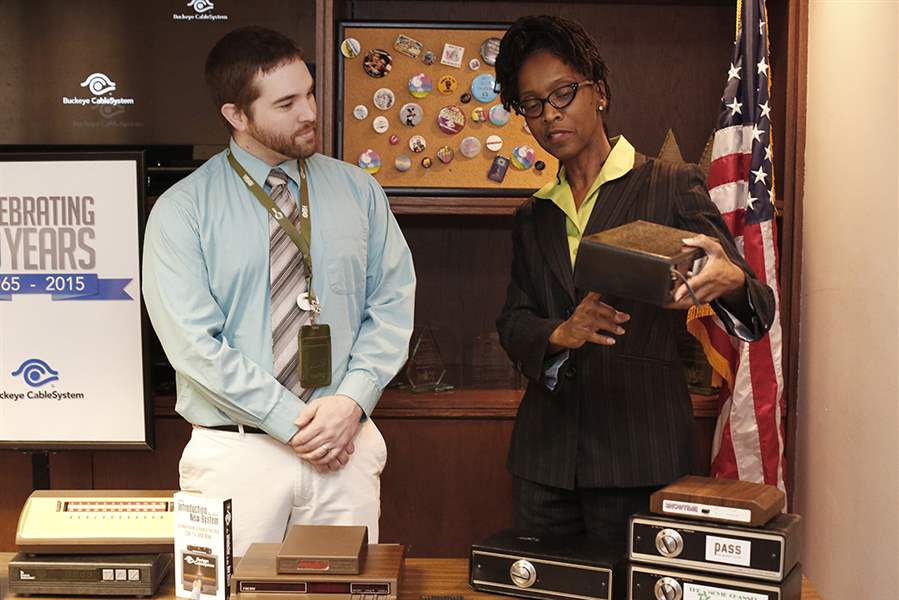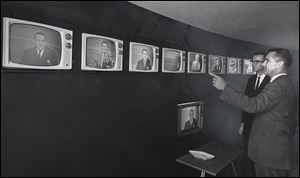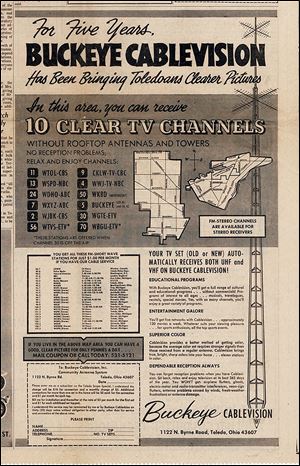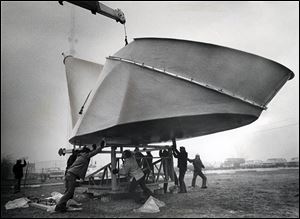
Buckeye channels its 50th year
Local company is at forefront of fast-changing cable industry
2/1/2015
Daniel McKee, technical support manager, and Florence Buchanan, vice president of competitive marketing, examine some of the equipment used in Buckeye’s 50-year history.
THE BLADE/JETTA FRASER
Buy This Image

Daniel McKee, technical support manager, and Florence Buchanan, vice president of competitive marketing, examine some of the equipment used in Buckeye’s 50-year history.
In cable television’s earliest days, the service was seen almost exclusively as a way to connect isolated rural communities to big city broadcasters they couldn’t otherwise receive.
Building a cable system in a metropolitan area already served by multiple networks was believed by most to be expensive and unnecessary. Why, businessmen wondered, would people pay to get something they already were getting for free over the air?
But a few pioneers thought cable could become the next big thing for communications, much in the way radio had earlier in the century.
Among them were Paul Block, Jr., and William Block, Sr., who together in 1965 would found what ultimately has become Buckeye CableSystem.
Still held by the Block family, the cable, Internet, and telephone company will celebrate the 50th anniversary of its incorporation on Tuesday, a milestone that cable historians say is remarkable.
“If they are still independently owned that is very unusual,” said Patrick Parsons, a professor of telecommunications at Penn State University and author of the book Blue Skies: A History of Cable Television. “Most of the cable systems in the country, especially cable systems in larger and midsize metro areas, are all going to be owned by Comcast or one of the other major players.”

Virgil Hartline and William Aubry of Buckeye Cablevision in August, 1966. With Buckeye’s launch, Toledo became one of the nation’s few cities with dedicated cable services.
There’s some debate among historians about who was first to offer customers cable television, but the reasons for those late-1940s systems were the same.
Television’s popularity was growing rapidly, but homes beyond reach of the day’s broadcast signals by distance or terrain were locked out of the new phenomenon. That could be remedied by erecting a mountaintop tower to collect the signal, then distributing it via cable to homes.
By the middle part of the 1960s, the industry was gaining momentum, but cable still wasn’t found in most cities.
“New York had some starter systems, but cable in the 1960s was a very different creature than cable today,” Mr. Parsons said.
With the advent of Buckeye Cable, Toledo became one of the nation’s first cities with dedicated cable services.
In 1966, when the service reached the first customers’ homes, it carried just 10 channels. It cost $5 a month.
Allan Block, chairman of Block Communications Inc. and son of Buckeye founder Paul Block, Jr., said the purpose at that time was simply to bring in Detroit television with a strong, clear signal — something not possible for most Toledoans with rooftop antennas.
It would be 13 more years before Buckeye began transmitting satellite channels.
Still, Allan Block said the company gathered 50,000 subscribers without a single satellite channel.
“It was good enough to get Buckeye off the ground,” Allan Block said.
When Buckeye launched, it did so with the help and expertise of Atlanta-based Cox Enterprises, which itself was a fledgling cable operator.

Buckeye Cablevision entered the homes of the Toledo area beginning in 1966 with 10 channels at $5 a month.
In fact, according to an in-the-works book about the company being written by former Buckeye executive Tom Dawson, the first discussions about creating a cable system in Toledo occurred during a meeting of Paul Block, Jr., William Block, Sr., and Cox chairman J. Leonard Reinsch during the 1964 Democratic National Convention, which was held in Atlantic City, N.J.
Although there to talk about another business matter, Mr. Reinsch pitched the idea, and the Blocks liked it.
Cox initially held a 40 percent stake in the company.
Another early partner was Ohio Bell, which installed and owned the wires through which Buckeye sent its signal. That, Allan Block said, kept initial costs down, but it restricted profits.
In the early 1970s, the Blocks bought out Cox’s share and began installing their own lines.
Expanded services
Cable technology has come a long way since those early days.
Take, for instance, the addition of channels. The first cable Buckeye used could only carry 12 channels. To add 12 more, the company had to run a second wire, which it did in 1974.
Things began changing more quickly as the 1980s rolled into the 1990s.
David Huey, who became Buckeye’s president and general manager in 1990 after a stint as executive vice president, was there during that dynamic time when Internet and phone service began to enter the cable arena.
“It was all launching at the same time,” Mr. Huey recalled in a recent interview. “It was a rapidly changing and exciting time. People adapted quickly or they didn’t survive.”
Mr. Huey and Allan Block both say one of the strengths that helped Buckeye was the company’s focus on customer service. Though the company had always tried to do right by its customers, Allan Block said in the 1980s the company put a strong emphasis on high customer-service standards.
Still, upgrading the system to the fiber-optic cables necessary for the future was a daunting task. Buckeye began replacing the old, coaxial cable system with fiber-optic cables in 1997.
The project to replace 1,900 miles of cable took four years and cost $180 million.

Workers position an earth-receiving station, also called a horn, in December, 1978.
Brian Kenny, library and archives manager at the Cable Center, a nonprofit educational organization for the cable industry, said Buckeye appeared to be ahead of the curve.
“I think we can safely say that Buckeye was early with making that investment compared to its peers,” Mr. Kenny said.
According to data from the Cable Center, the infrastructure spending between 1996 and 2005 — a time when many were investing in fiber — peaked in 2001.
“That’s where I give the Block ownership tremendous credit for saying, ‘Hey, this is important for our community, and we want to do what is right and best for our community,’” Mr. Huey said.
In Allan Block’s mind, one of the biggest decisions for the company was to build a professional-quality local sports network that could “raise up” local sports.
Called BCSN, the channel launched in 2004.
At the time, Allan Block was told BCSN couldn’t be done, at least not for a reasonable cost and at a high quality. But it has proved successful, he said, and adds real value to the company.
“Cable is a competitive business now. All our services are competitive services. It is my feeling that BCSN has made a significant difference for us in terms of a stronger competitive profile,” he said.
Jeff Abbas, current president of Buckeye Cable, said that the 24-hour sports network truly sets the company apart. Before coming to Buckeye, Mr. Abbas was the president and chief executive officer of the National Cable Television Cooperative, a not-for-profit corporation that represents more than 850 cable providers across the United States.
“A local sports network like that is exceedingly rare,” Mr. Abbas said. “I know of none other than BCSN, and I was in that space.”
Broadband a key
As Buckeye Cable looks to the future, its executives agree that high-speed data will be the predominant business. Allan Block says it’s important to find ways to add value to that service.
“I think the key in broadband is to make sure it is the technologically most advanced, the highest speed, and is a value-added service, not a commodity service,” Allan Block said. “There is competition. We’ve got to differentiate our broadband as the clearly better, market-leading service. That means investment, technology, speed.”
Mr. Abbas said there’s still a lot of value in video services, but the company understands that not everyone is likely to want everything that is available. Some may want everything, some may just want movie channels, some may just want to access Netflix.

Whatever the situation, Mr. Abbas said the company needs to ask, “What do our customers want; what’s the best way to provision it?”
Mr. Abbas said a good example of that has been Buckeye1, a package the company launched last fall that provides subscribers with an Apple iPad, high-speed Internet, access to Buckeye TV Everywhere — which allows customers to watch streamed content from more than 60 providers on their computers, smart phones, and tablets — and an all-access subscription to The Blade.
The Blade is owned by Block Communications Inc., which also owns Buckeye Cable.
Mr. Abbas said Buckeye1 has been selling so well, the company is likely to offer a premium version soon.
Buckeye is also in the process of launching its Brainiacs service, which gives subscribers support for all their electronic devices. Officials say many issues can be corrected remotely, but if something requires a service call, the service tech will drive to the customer’s location.
For the community
Had they wanted to, the family certainly could have sold Buckeye during the many consolidation rushes the industry has seen. But Allan Block said that’s never been the goal.
“The Block family and the Toledo Blade Co. were interested in serving the community,” Allan Block said. “We weren’t doing this as speculators, we were doing this to serve the community. Yes, we wanted the business to be successful. Yes, we wanted to add value. But it wasn't about speculating.”
Mr. Abbas argues that being family-owned and being intensely local gives Buckeye something that large firms don’t have. For one, customers who call for service get to talk to people who live in their community. He also said the management strategy can take the long-term approach.
“The Blocks have a great structure for managing according to a philosophy, as opposed to how many bucks did you make last quarter, and that’s a good spot to be in,” he said.
John Robinson Block, the brother of Allan Block and the son of Paul Block, Jr., said there was always a sense from the family that cable would be a success.
“I’ve been a witness to its development since childhood and it’s been an exciting process,” said John Robinson Block, the publisher and editor-in-chief of The Blade.
The Blade and Buckeye CableSystem have had a close, cooperative relationship over the years, and John Robinson Block praised his father’s foresight in getting into the cable business.
“My father was a genius when it came to looking at the future,” he said. “He was certainly the kind of man who was frustrated much of his life by being so far ahead of his contemporaries. He was just ahead of his time. He understood the day would inevitably arrive when the wire would carry everything that people need into their homes, including the newspaper.”
Contact Tyrel Linkhorn at tlinkhorn@theblade.com or 419-724-6134 or on Twitter @BladeAutoWriter.